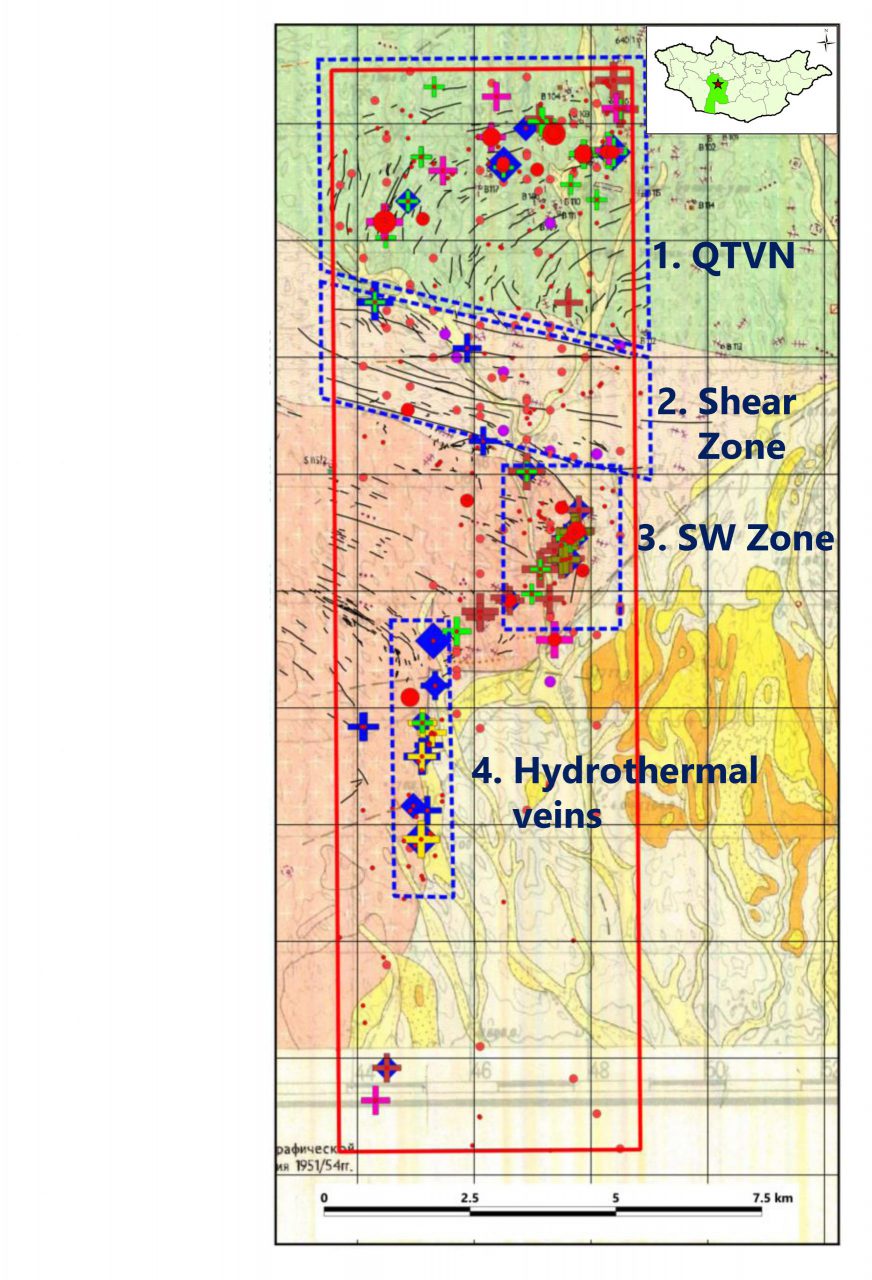
“Mongold’s Naran Mandal Gold Operations is located in Mongolia and employs some 500 people including contractors. We are a proud major employer and economic contributor in the region.”
Our Strategy |
Mongold’s exploration strategy is to exploit known deposits with an initial $3.1 million committed between 2022 and 2026. |
|
Phase 1: Work completed in 2022
|
Phase 2: 2023/24
| Phase 3: 2025/26
|
Baruun Jalga
Khovd Province – 1318 ha Located in the Tien Shan belt. Wolfram and granitoid related gold occurrences surround the license
Ikhbulag
Gobi Altai Province – 2086 ha Located within the Tien Shan belt.
Ulaan Ereg
Bayankhongor Province – 9546 ha Abundant quartz veins with prospective alteration styles in a known orogenic gold terrain located near Project King. Grab samples resulting Au.
Khashaatiin Khundii
Bayankhongor Province – 7178 ha Located within the Bayankhongor Belt, and is surrounded by mineral occurrences, quartz vein density was found on the license with light indications of mineralizing processes.
Naran Mandal
Bayankhongor Province – 1053 ha Located in Bayankhongor gold belt in the Orogen type (deposit classification) ore genesis. Au + Ag + low sulphide. Narrow vein high grade ores.
Teel
Uvurkhangai Province – 679 ha Located along the trend from Naran Mandal Gold Operations within the Bayankhongor belt.
Altgana
Selenge Province – 4937 ha
Located within the Boroo-Gatsuurt district with frequent quartz veins with
mineralized quartz veins located north of the license. Grab samples resulting Au
and Ag.
Mandal Sumber
Tuv Province – 614.61 ha located in Mandal Sumber soum with hydrothermal, mesothermal lode gold, quartz sulphide Au, quartz vein.
Buregkhangai
Bulgan Province – 60 ha
Sheeted quartz veins occur on the license on the margin of a major placer gold
district.
Gashuun Khudag
Dundgobi Province – 8266 ha
Gold mineral occurrences around the license. The relatively large area of the
license and cassiterite prospective. Tin mineralization potential is high.
Shijir
Selenge Province – 385 ha Located within the North Khentii belt. Prospective host rocks.
Zegel
Khentii Province – 4092 ha
Quartz sulphide stockwork associated with aplite dykes.
Khooloi
Khentii Province – 5591.32 ha
Visible quartz-chalcedony epithermal veins +- sulphides. Positive Au grades.
Zagal
Dornod Province – 2640 ha
Mineral occurrences around the license. Located on Mesozoic sediments and has
coal-uranium potential.
Khovd
Govi Altai
Bayankhongor
Uvurkhangai
Ulaanbaatar
Dundgovi
Khentii
Dornod

Mongold’s plan to 2026:
- Continuing to increase production and exploration activities onsite at Naran Mandal Gold Operations;
- Exploring and building up resources on its two most promising exploration licenses;
- Closing the most advanced deal in its Central Asian M&A pipeline; and
- Looking for additional acquisitions to increase the size of the company and diversify risk.
Outside of the Naran Mandal Gold Operations, the two largest and most-extensively tested projects in our portfolio are:
- Ulaan Ereg; and
- Khooloi
ULAAN EREG HIGHLIGHTS

- Ulaan Ereg has a surface area of 9,500ha and is located
 within the Bayankhongor Ophiolite Belt, approximately 43 km west of the Naran Mandal Gold Operations.
within the Bayankhongor Ophiolite Belt, approximately 43 km west of the Naran Mandal Gold Operations. - Completed prospecting activities include 92km2 of specialist mapping, about 250 rock chip samples, and over 7,250 geochemical samples with assaying completed.
- Geology: Granite and granodiorite of Proterozoic, terrigenous of Mezozoic age. Baidrag gold zone in Bayankhongor gold belt.
- Mineralization: potentially of epithermal genesis with gold mineralization in this area related to a Proterozoic intrusion contained within a major shear zone.
- Mineralization type: the shear zone contains elevated gold levels in soil samples combined with key indicator minerals and is believed to potentially host an orogenic gold deposit.
- Sample results showed 120 ppb – 250 ppb of Au.
KHOOLOI HIGHLIGHTS:

- Khooloi is approximately 5,600ha and is located in the Kherlen soum of Khentii province. It is readily accessible with access to infrastructure (power lines, paved roads, water).
- Completed prospecting activities include 55km2 of specialist mapping, 274 rock chip samples, over 2,000 geochemical samples with assaying completed.
- Historical exploration: the project was surveyed informally by Russian and Mongolian teams between 1940 and 1975 leading to the discovery of several occurrences of fluorspar, copper, iron, wolfram, base metals, gold placer and nonmetals.
- Geology: Intrusion of Carboniferious, volcanics of lower cretaceous, terrigenous (sandstone, conglomerates, gravelstone, mudstone) of Mesozoic age.
- Metallogenic belt: the project is located in Eastern Mongolia on a Mesozoic structural formation containing mainly base-metals.
- Mineralization type: potential for low sulphidation Cu-Pb-Zn and epithermal gold lodes.


